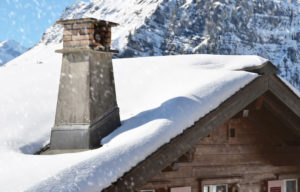Temperatures are dropping, leaves are changing and starting to fall, and many parts of the country have experienced the first snowfalls of the season. Fall is in full swing, and winter is just around the corner! With the change in the weather comes a change in how we use our heating appliances; fall and winter are known as burning seasons because of how often fireplaces, inserts, stoves, and other fuel-burning heating appliances are used.
 The Farmer’s Almanac has predicted that this winter will have big chills and strong storms; a fireplace can help create a warm, welcoming environment in your home no matter the weather. While chimney systems are built to burn fires year after year, they do need regular care, maintenance, and upkeep in order to operate safely and efficiently. The following tips and tricks can help ensure your fireplace and chimney are ready for the arrival of burning season.
The Farmer’s Almanac has predicted that this winter will have big chills and strong storms; a fireplace can help create a warm, welcoming environment in your home no matter the weather. While chimney systems are built to burn fires year after year, they do need regular care, maintenance, and upkeep in order to operate safely and efficiently. The following tips and tricks can help ensure your fireplace and chimney are ready for the arrival of burning season.
1. Schedule a sweeping and inspection as soon as possible
Burning season may be underway, but it’s still not too late to schedule a chimney sweeping and inspection! A chimney sweeping should be done at least once per year to remove soot, ash, and flammable creosote from the flue; likewise, inspections should be done annually to check for signs of damage or deterioration to the fireplace or chimney.
A chimney sweeping by a CSIA-certified chimney sweep can help ensure your fireplace is burning efficiently, extend the life of your chimney system, and significantly reduce the risk of a chimney fire. Fall and winter are the busiest seasons for chimney sweeps; because of this, it may take several weeks before your appointment can be scheduled. Want to beat the rush next year? Plan ahead and schedule your chimney maintenance in the offseason!
Have a gas fireplace? You still need to schedule a chimney inspection! Annual inspections of gas fireplaces are important to ensure that no components have shifted, no gas leaks are occurring, and the venting system is undamaged and has no blockages.
2. Choose the right firewood
Whether you have an insert, open-hearth fireplace, stove, or even an outdoor fire pit, the best fuel for your wood-burning fire is seasoned firewood. According to the CSIA, seasoned firewood is “wood that has a moisture content between 20-25%.” This low moisture content is achieved by cutting, stacking, and exposing wood to the elements for 6-12 months.
Seasoned wood produces less smoke, burns at a higher temperature, and produces less creosote than freshly cut or “green” firewood. Burning green wood should be avoided whenever possible; in addition to being difficult to ignite because of the high moisture content in the wood, green wood burns dirtier and produces excessive smoke – and creosote. Burning large amounts of greenwood often result in a mid-season call to the chimney sweep!
While it can be tempting to burn paper, packaging materials, or leftover scrap wood in the fireplace – particularly when unwrapping presents during the holidays – only firewood should be used in indoor fireplaces. Styrofoam, stained or painted wood, or even printed paper can release dangerous chemicals when burned; this can impact the air quality in your home or cause respiratory issues for friends and family. Likewise, burning plastics can melt onto fireplace components and cause long term damage to the chimney system.
3. Maintain smoke detectors and safety equipment
In the United States, three out of five fire-related deaths were in homes without working smoke alarms. Regularly testing and replacing smoke alarms, carbon monoxide detectors, and fire extinguishers are an important part of keeping friends and family safe when the fireplace is in use. Smoke and carbon monoxide detectors should be on every level of a home, as well as outside sleeping areas. Test alarms every six months and replace batteries as needed; replace safety equipment every 7-10 years to ensure they meet modern safety standards and technology.
A fire extinguisher should be purchased and placed in an easily-accessible area near the fireplace. Available at almost every big box or home improvement store, a working fire extinguisher can be used to prevent an unsafe situation from turning dangerous. A log rolling out of the fireplace, a fire burning out of control, or a stray ember landing on nearby furnishings are all situations where a fire extinguisher can help prevent devastating damage to a home.
4. Keep décor away from the fireplace
The stockings may have been hung by the chimney with care – but they need to be moved before the fireplace is used! During the holidays – and year-round – our mantles can hold décor such as garland, bunting, mementos, and more. Moving any hanging mantle décor out of the way before the fireplace is used can prevent stray sparks or embers from accidentally igniting a stocking; likewise, all carpets and other furnishings should be at least three feet away from the fireplace when in use.
Contact Jack Pixley Sweeps for your chimney needs this burning season
Following a few simple tips can keep your home safe and stress-free this burning season. Since 1977 staff has been providing the Minneapolis/Saint Paul area with quality, trustworthy fireplace and chimney services. For more information on fireplace safety or to schedule your next chimney sweeping or inspection, contact Jack Pixley Sweeps today!
